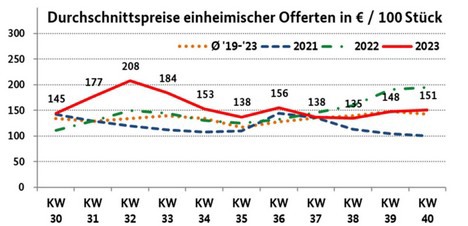Domestic cauliflower apparently dominated the scene. They were mostly available in packs of 6, only in Hamburg were they also available in assortments of 8. In the Hanseatic city, the domestic offerings were flanked by a few Polish ones, while in Munich they were unrivaled. Belgian and Dutch batches appeared in Frankfurt and Cologne. In Berlin, few imports from the Netherlands joined those from Germany. Availability was sufficient to meet demand.
 © BLE
© BLE
Interest was uneven, and business proceeded accordingly: at times, accommodations had improved, at other times they were noticeably limited. Consequently, no clear line could be discerned in the prices; reductions could be observed just as much as increases. Increases in price, however, were somewhat more frequent. In Berlin in particular, prices rose into the new week due to declining availability.
Click here to go directly to the complete market and price report.
Apples
The assortment presented itself wide-ranging, with domestic fruits playing the main role. Numerous varieties were available, with Elstar, Jonagold and Boskoop forming the basis of the product range. Topaz, Rubinette and Pinova gained strongly in importance, and Gala were also increasingly sighted. From Italy, Royal Gala, Granny Smith and Golden Delicious were the main varieties.
Pears
As usual at this time of the season, Italian imports predominated. Santa Maria, Abate Fetel and Williams Christ were in the forefront. From Turkey came Santa Maria. From the domestic market mainly Conference, Williams Christ and Xenia arrived. The prices, so far quite high, often remained stable.
Table grapes
Italian Italia, Michele Palieri, Crimson Seedless and Sugraone played the leading role alongside Turkish Sultana. Imports from France, Spain and Greece complemented the action. Demand was sometimes friendly, sometimes rather limited. In Munich, Sultana and Crimson Seedless from Turkey were rather small-fruited, but scored with their taste.
Damson plums
The season ended rather unspectacularly: deliveries narrowed, quality slowly declined, and a certain customer saturation could not be denied. Stanley from the Republic of Moldova predominated. Few domestic domestic plums, as well as the varieties President and Presenta appeared only sporadically.
Lemons
South African Eureka dominated the scene. Spanish Primofiori sometimes arrived inadequately. Prices trended upward at various times as accommodations improved from time to time.
Bananas
Supply and demand were sufficiently balanced. Marketers therefore rarely had cause to modify their previous demands. Only in Hamburg were prices seen to be rising, as availability here had noticeably reduced.
Salads
The range was dominated by domestic offerings. Dutch and Belgian products supplemented it. Spanish iceberg salads gained noticeably in Berlin; as they were cheaper than the competition, they were able to gain some market share. Overall, interest was satisfied without major effort.
Cucumbers
Domestic snake cucumbers dominated over Dutch ones. Spanish lots had almost caught up with Belgian batches in terms of volume and were now setting the tone in Berlin. The Central European season was slowly entering the home stretch, with several new domestic deliveries no longer arriving.
Tomatoes
Dutch and Belgian offerings dominated the scene. Italian, Turkish, Polish and domestic products sometimes played a more important, sometimes only a minor role. The first Moroccan round of tomatoes arrived in Munich, where they cost similar to the Belgian competition.
Sweet peppers
Dutch inflows predominated. They were most likely to be flanked by Spanish deliveries. Turkish and Polish imports played a small role. The marketing was supplemented by Belgian and domestic offerings. Valuations trended upward rather than downward as overall supply was slightly limited.
Source:
